Bio Mechanical Stimulation – Battery Supported Handheld Device
The Regeneration through movement & rhythm of muscles with Matrix Therapy

An innovative non-invasive therapy for a variety of different disorders within the musculoskeletal (MSK) system
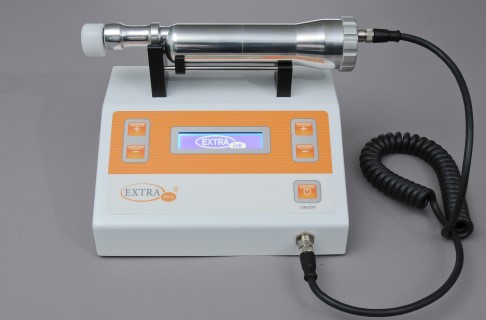

What is BMS?
BMS is non-invasive externally applied mechanical stimulation of defined amplitude and frequency to the skin, connective tissue and muscles. It is a 100% natural and safe method of imparting the bodies natural rhythms back into the connective tissue, the extracellular matrix and the musculotendinous bone junctions which can be treated by this biomechanical stimulation with the mechanotherapeutic approach of cell biological regulation medicine using the BMS device. Complexly located disorders, imbalances, pain and weakness can be efficiently managed or avoided with BMS matrix therapy and existing therapy combined.
Device specificsThe development of Bio-Mechanical Stimulation matrix therapy treatment is based on continuous clinical study together with scientific and academic research about the vital functions of the Extra-Cellular Matrix (ECM) and its relationship to the physiological rhythmic movement and vibrations of the human musculature.


Bio-Mechanical Stimulation matrix therapy is a safe, natural, non-invasive, mechanotherapy rhythm treatment that improves the mobility of joints, enhances skeletal muscle repair and promotes the regeneration of injured muscles within the musculoskeletal (MSK) system. It targets the area which surrounds the cell and is responsible for both the nutrient supply to and waste disposal from the cell. The aim of biomechanical stimulation treatment is to restore healthy and vitally to the muscles, fascia and tendons in the affected tissues.
BMS matrix therapy is based on the core physiotherapy concepts of movement and exercise to restore movement and function in the musculoskeletal system.
BMS matrix treatment is especially effective in regard to musculoskeletal complaints. In addition to manually-performed lymph drainage, osteopathy, chiropractic, atlas therapy, shockwave and other conventional therapies, BMS has an immediate effect on the musculoskeletal condition and pain relief.
BMS matrix therapy influences the Extra-Cellular Matrix (ECM) between the capillaries and the cells themselves. It acts specifically on the metabolic dynamics in the extracellular matrix. BMS distinguishes itself from many therapeutic measures in physiotherapy, and differs from many conventional vibration applications which are often vertical to the musculature on the tissue and work with frequencies in a range far beyond the upper biological frequency limit of 30 Hz.
This inherent muscular rhythm is imitated from outside the body through biomechanical stimulation (BMS) along the longitudinal fibres of the muscle. The mechanical stimulation replicates the biological vibration patterns of the muscles. The biological frequency window of 8 Hz to 30 Hz and the amplitude windows of 0.1 to 5 mm must be adhered to.
The therapist works with biomechanical stimulation (BMS) matrix therapy to directly influence rhythm, microcirculation and metabolism – the physiological building blocks of repair and regeneration.
In combination with manually performed lymph drainage, osteopathy, chiropractic, atlas, shockwave and other conventional therapies, BMS has an immediate effect on the musculoskeletal condition and on pain relief.
What is biomechanical stimulation and Matrix Therapy?
The aim of biomechanical stimulation treatment is to restore the health and vitally of the muscles, fascia and tendons in the affected tissues.
The muscular rhythm can be imitated from outside the body through biomechanical stimulation (BMS) via Matrix Therapy applying the Rhythm along the longitudinal muscle fibres.
As is known of energetically open systems (Prigogine 1987), the natural frequency of a vibrational system (muscles) adjusts to the vibration of an external pathogen or assumes its rhythm.
The muscular rhythm can be imitated and stimulated externally by an appropriate vibration entry.
This mechanical stimulation must be related to the biological vibration patterns of the muscles. A biological frequency window of 8 Hz to 30 Hz and an amplitude window of 0.1 to 5 mm must be adhered to.
The vibration input occurs in the longitudinal direction of the musculature. Physiotherapists work with biomechanical stimulation (BMS) to directly influence rhythm, microcirculation and metabolism – the physiological building blocks of regeneration.
BMS distinguishes itself from many therapeutic measures in physiotherapy which are based on the simple stimulus-reaction principle. It also differs from many conventional vibration applications which are often applied vertical to the musculature on the tissue and work with frequencies in a range far greater than the upper biological frequency limit of 30 Hz.
Direction of the human body’s natural vibrations
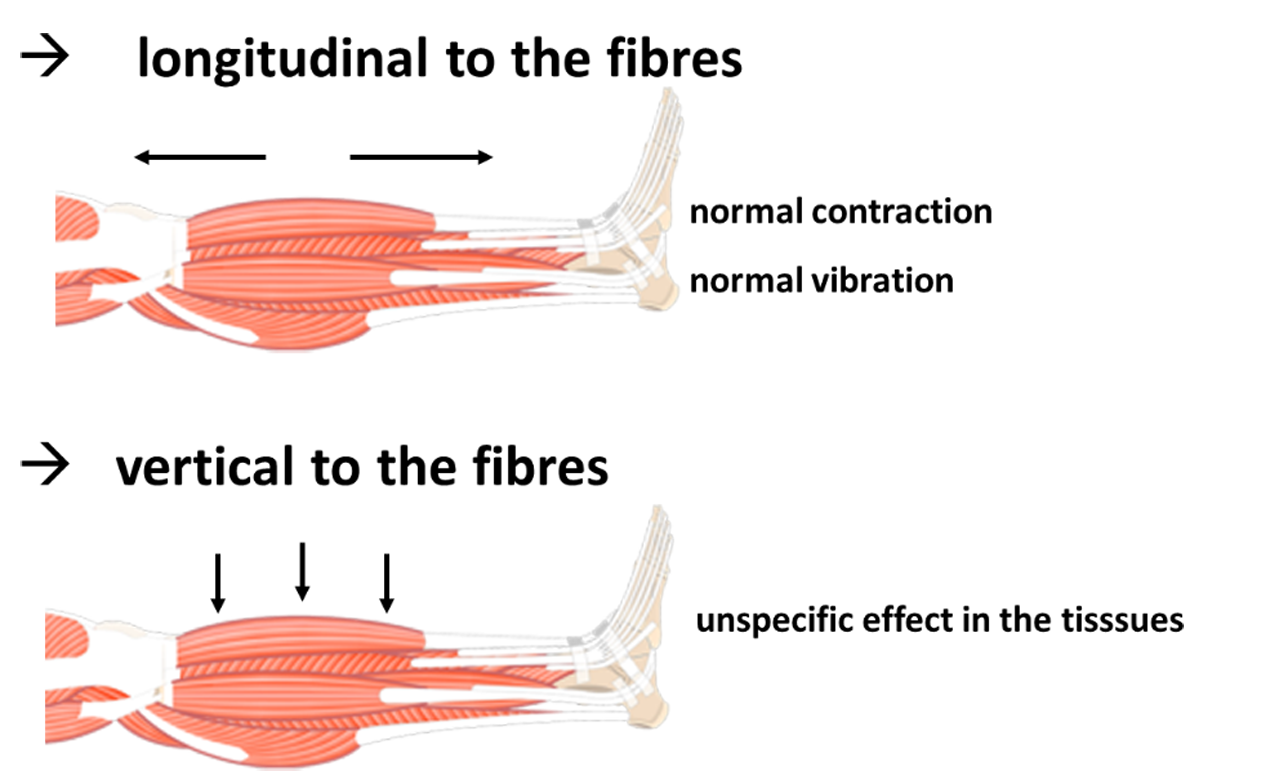
Differences between biomechanical stimulation and various vibration, muscle stimulators, as well as conventional electrical stimulation, shockwave treatments.
Since the 19th century, physicians around the world have used different forms of vibration or muscle stimulation. In recent years, rehabilitation programmes and various physiotherapists have begun to realize – and focus on – the biological value of physiological processes which take place within an organism. Diverse levels of energy, electricity, charge, pressure and traction forces regulate the preferential absorption, amplification, modulation, transformation, and transmission of different wavelengths. Pressure and traction forces are correlated with specific rhythms of frequency patterns. The Biomechanical stimulation of Matrix Therapy goes beyond the traditional sense of micro-vibrations that are produced by skeletal muscles and transmitted to the surrounding tissue.
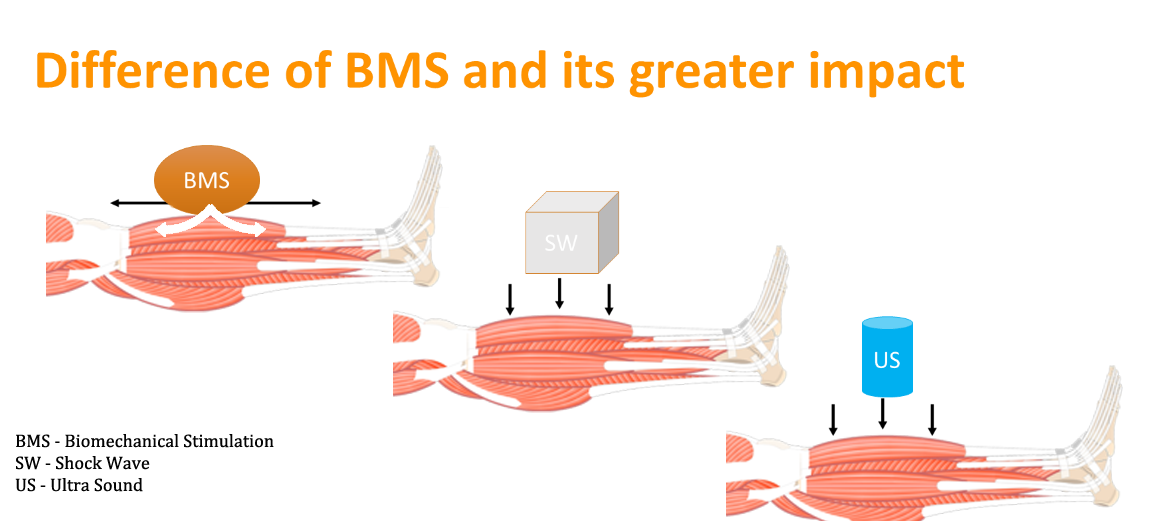

Biomechanical stimulation: scientific facts and history.
Even at complete rest, alternating contractions of the proportionate muscle fibres is about 2 – 3% of muscle micro-vibration. Constant rhythmically alternating contractions are found in every muscle.
For example, if suffering from a cold. during weight lifting or experiencing a chill feeling prior to getting a fever, the micro vibration through our muscle contraction reacts at a higher frequency and amplitude with the tremor shown as a sign of activation in microcirculation system. Stimulation of the microcirculation in the Extra-Cellular Matrix space (ECM) is performed by the mechanical input and external stimulation between the venous and lymphatic capillaries. Because of the contraction along the muscle fibres, compression of the capillary leads to subsequent elastic restoration. The specific pressure and suction effect activates the microcirculation. Therefore, metabolic end products, toxins or cell decay products can be disposed of. These muscle-driven microcirculations also provide an intact and permeable rhythm to the ECM, ensuring the supply to all cells in the tissue. The biomechanical stimulation matrix therapy is now wildly practiced in physiotherapy and sports medicine.
Physical muscle tremor
| frequency | amplitude | |
| at rest | 8 – 12 Hz | 0,1 – 0,5 mm |
| during physical activity | up to 30 Hz | 1 – 5 mm |
History of biomechanical stimulation therapy – Sport Science. In 1960, Professor Biermann from the University of Sport Science, Leipzig, Germany, researched and published the first biomechanical stimulation journal in relation to the human body.
Prof. Biermann In 1960 developed the first BMS device and applied it in sport science, to gymnasts, wrestlers and weightlifters in Eastern Germany during the DDR era. BMS devices increased an athlete’s performance, promoted regeneration and improved extensibility.
Later Prof. V. Nazarov from the USSR, further developed the BMS device and introduced the concept into sport medicine. Whereby in 1976/77, his first experimental devices for BMS were created and, thereafter, these methods were subject to over 20 years of the strictest secrecy. The BMS remained in the hands of the Eastern Bloc sports scientists who used BMS devices for performance enhancement, better regeneration and extensibility. In 1990, Prof. Nazarov introduced the BMS device to West German sport science.
Biography of Prof. V. Nazarov the father of biomechanical stimulation (BMS)


The inventor of biomechanical stimulation, Prof. habil. V. Nazarov, was born on 31st January 1936 in Belorussia.
1954–1959: University education in human anatomy and physiology
1960: Master of Sport in the USSR in apparatus gymnastics
1962–1982: University lecturer, instructor and professor at the Technical University of Riga
1968: Doctor of Sciences
1974: Prof. of Sciences (habilitation)
1976–1986: Professor at the Technical University of Riga
1976–1992: Chairman of the Scientific Council for Biomechanics at the Academy of Sciences of the USSR
1982–1994: Dean, Chair of Biomechanics, Minsk Academy (Biomechanics was the most important Professorship of the Soviet Union)
Since completing his work on new biomechanics Prof. Nazarov was involved with research into muscle vibration. The first experimental apparatus for muscle stretching was constructed in 1976/77. Following this the method was kept top secret for over 20 years. It was only after the political changes that this incredible knowledge also became available in the West.
Siegfried Hofmann, a German sports scientist encountered the BMS concept during a sports event and developed and patented the first BMS device in West Germany.
In 1996, after several years of work, he also created and patented the highly effective and special form of the oscillating head (resonator) in the form of an Archimedean spiral.
The relevance and importance of the Archimedean spiral is because it produces different path speeds at the same angular velocity upon the skin surface. Due to these rolling moments, stretching is relatively proportional to deep tissue, such as the fascia, that is along the length of the fibres and simultaneously stimulates stretch-sensitive organs (the muscle spindle). By stimulating the Golgi tendon organ, muscles associated with α motor neurons are inhibited (self-inhibition = relaxation). This ensures that the tissue’s total receptors can retract and relax, including the proprioceptors (myosin, Golgi). Healthy organisms require calm movements within the body (vagal nerves), and full activation of the vibration range of active movement (sympathetic nerves). These specific harmonic wave forms from the resonator are introduced into the tissues along the course of the muscle fibres via the biomechanical stimulation.
The BMS Therapeutic Apparatus can generate these natural biological vibrations between 5-30Hz in the direction of uniform contraction/stretching of muscles, fascia and other soft tissues through its unique Archimedean spiral, which promotes the release of the extracellular matrix whilst softening the soft tissues. The metabolism can then activate the discharge of inflammatory factors, such as, lactic acid and other metabolic wastes which treats both the symptoms and root causes, and to fundamentally relieve pain. The mechanical stimulus introduced externally into the body via the machine must be consistent with the body’s natural biological vibration model of the muscles to bring about a positive and efficient treatment result.
To date, many and various names have been given to this BMS concept: Bio-Mechanical Stimulation Matrix Therapy, Bio-Mechanical muscle stimulation, Nazarov stimulation, neuromuscular stimulation, matrix rhythm therapy, ZRT, MRT, Matrix Therapy, to name a few.
Many doctors have conducted further clinical studies using this concept and have been very successful in the practical application of Bio-Mechanical Stimulation Matrix Therapy.
We are grateful to the pioneering scholars like Pischinger and Hartmut Heine who laid the foundations for BMS and with their work on the regulation of the cell milieu system and the importance and function of the ECM making all this possible.
The physiological aspects and the relationship of biomechanical stimulation to the anatomy of the Extra-Cellular Matrix space.
The mechanical stimulation regulates the micro area around the cells, so that health, wellbeing and performance are restored in the macro area. The goal of BMS matrix therapy is to optimise the long-term health of the body, rather than masking a problem or achieving only a temporarily improved state. This innovative physiotherapeutic method aims at the optimisation of metabolic pathways on the cellular level. It should have an immediate effect on the musculoskeletal condition. The Biomechanical stimulation (BMS) of the Matrix Therapy acts specifically on the metabolic dynamics in the extracellular matrix. In the field of rehabilitation BMS therapy is especially effective in relation to musculoskeletal complaints. BMS therapy underlines the active principle of natural muscle vibration.
Regeneration through rhythm of muscles
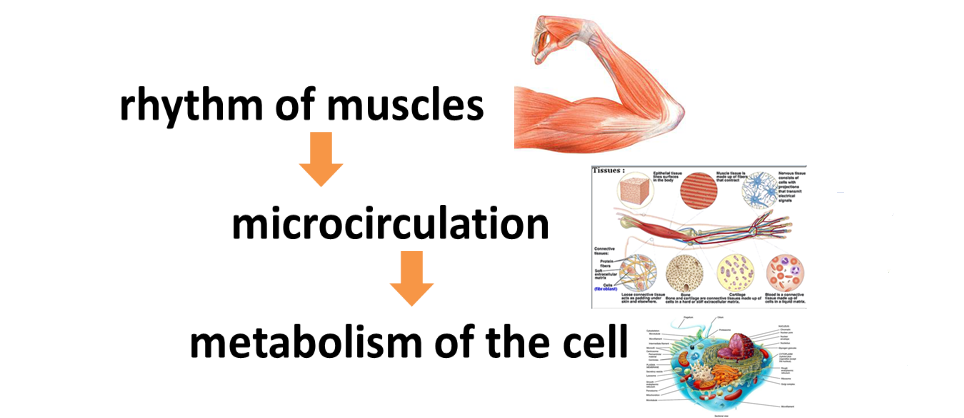

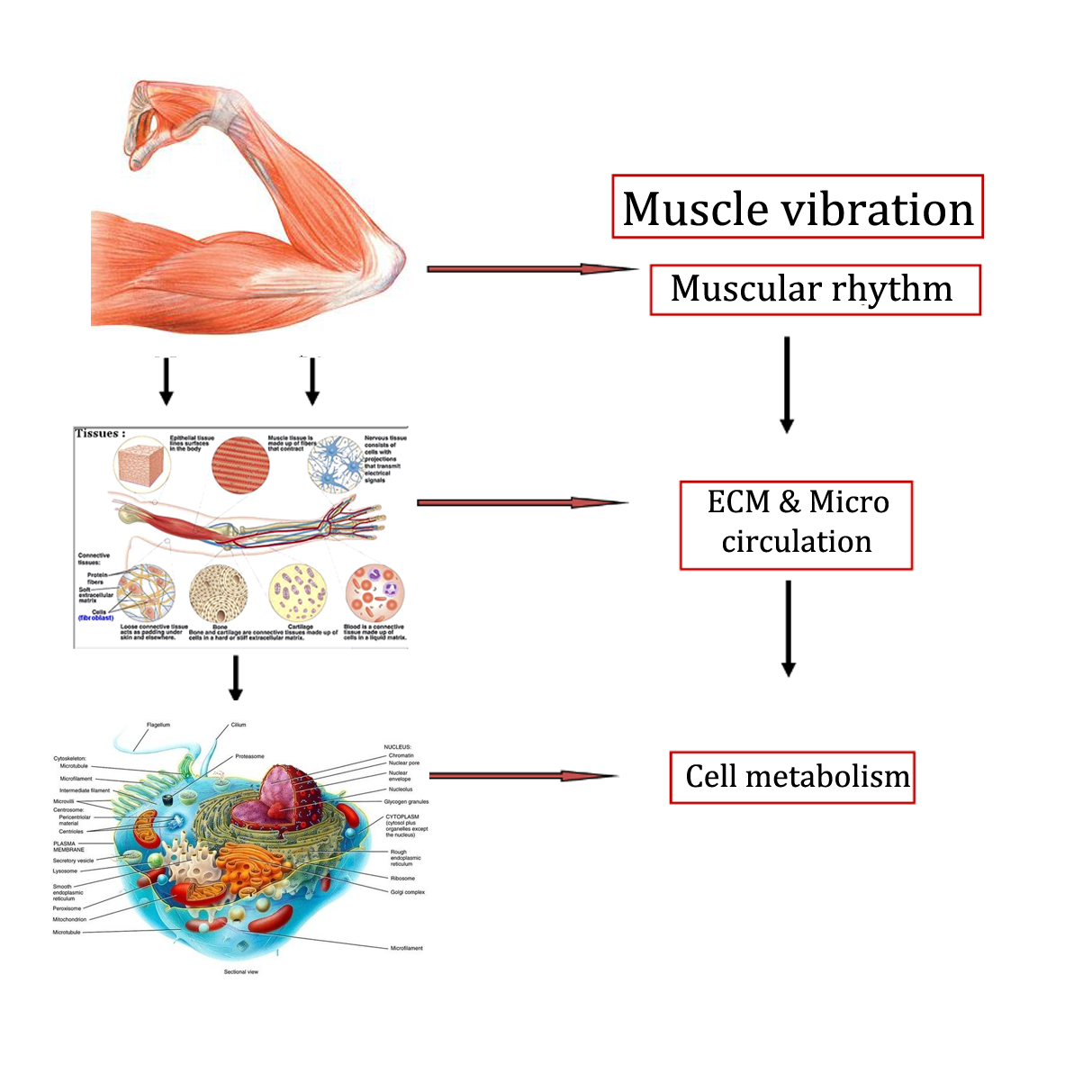

Various biomechanical stimulation studies
1. Independently conducted biomechanical stimulation study on behalf of Extrazell
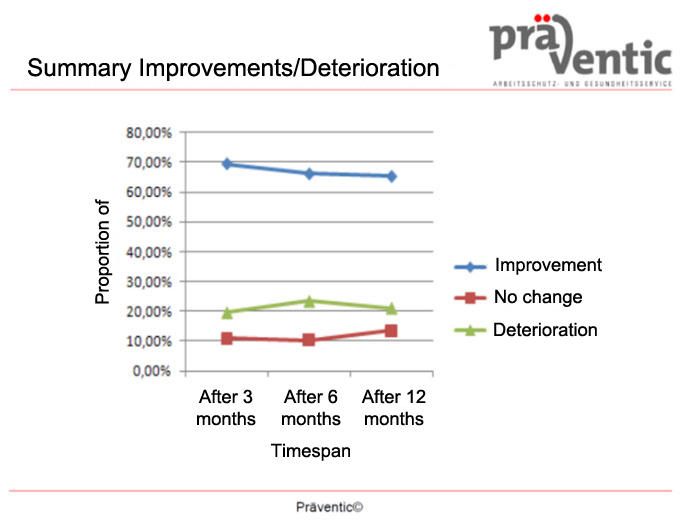

Read the therapy study
2. BIOMECHANICAL STIMULATION THERAPY
Biomechanical Stimulation Therapy – An Efficacious Method for Facial Scleroderma with Reduced Oral Aperture
3. BIOMECHANICAL STIMULATION THERAPY
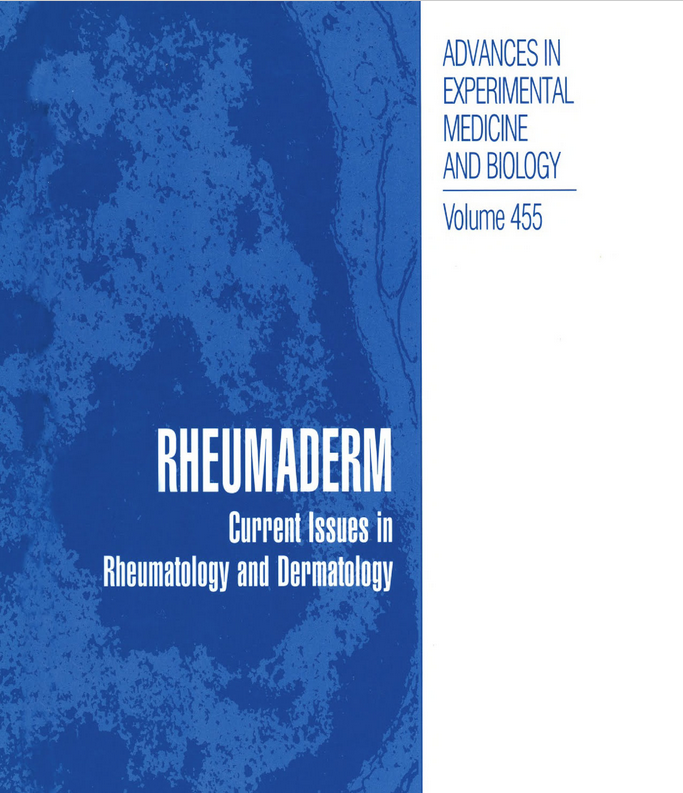

A Novel Physiotherapy Method for Systemic Sclerosis
- Klyscz,* G. Rassner, G. Guckenberger, and M. JUnger
Department of Dermatology
University Hospital of Tübingen
Liebermeisterstr.25
D-72076 Tübingen, Germany
ABSTRACT
To improve the mobility of joints, particularly of the finger joints and the mandibular joint, and to reduce the edema of the skin, various physical therapies have to be used in patients with SSc. As the quality of patients’ life depends on the use of their fingers and of their mouth, these therapeutics belong to the basic measures in the treatment of SSc. In addition to the manually performed lymph drainage a new method\ the biomechanical stimulation therapy, has proven to be efficacious to improve the mobility of the joints and to reduce the edema in SSc-patients. By devices of various size, longitudinal vibrations are transduced to patients’ body: finger, hand, face, mandibular joint, the oral mucosa, the legs and the trunk. In 6 patients we found: significant (p<O.05) increase of skin score, grip strength, mobility of joints (10-30%). No side effects were observed. We conclude from these data, that skin, mucosa, joints and patients’ quality of life are improved by the biomechanical stimulation therapy in a clinical relevant degree
- Biomechanical stimulation therapy as physical treatment of arthrogenic venous insufficiency
- Effect of Biomechanical Stimulation On Skeletal Health In Adolescent And Young Women With Anorexia Nervosa
Boston Children’s Hospital
https://clinicaltrials.gov/ct2/show/NCT01100567
- Acute Effects of Local Vibration With Biomechanical Stimulation on Low-Back Flexibility and Perceived Stiffness
Kent State University, Department of Athletic Training
- Sklerodermie systemische (Systemic scleroderma)
http://www.enzyklopaedie-dermatologie.de/artikel?id=14032
Above article translated into English
- Mechanical stimulation shown to repair muscle – Wyss and SEAS teams find new strength in regenerative medicine
http://news.harvard.edu/gazette/story/2016/01/mechanical-stimulation-shown-to-repair-muscle/
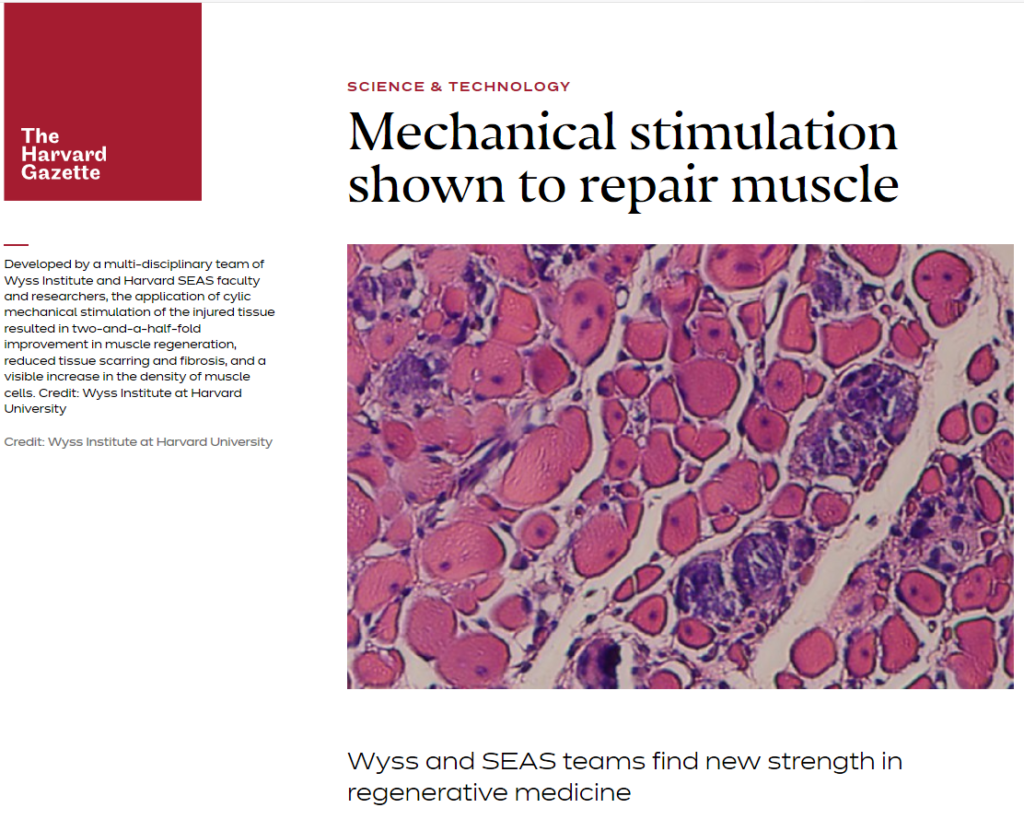

Click here for the full research paper
The history and development of the Extra-Cellular Matrix and related matrix therapies
The Extrazell company is committed to a balanced sport medicine science approach that integrates all elements. Simply investing in one area is not enough for them. In order to establish a robust sports medicine science capability, they commit to a holistically balanced approach. Extra-Cellular Matrix, matrix therapy and related subjects are evolving areas thanks to the increasing experience of physicians, medical education, clinical research and administration. This is apparent not only in science but also in treatment, exercise and physical activity supporting general healthcare. The structural dynamics of fasciae and muscles, the ground substance, and the biochemistry of the Extra-Cellular Matrix and its dynamic signalling and communicative behaviour within our body need further research by practitioners and researchers. As teams continue to look for innovative ways to gain a competitive edge, sports medicine science has emerged as the next frontier of significant value creation. In the past, practitioner and scientists have leaned heavily on qualitative analysis to answer questions related to Extracellular Matrix study globally.
Further reading & information
| Biomechanical Stimulation related | Journal of Rheumatic Diseases and Treatment Berg et al. J Rheum Dis Treat 2016, ISSN: 2469-5726 |
| Acute Effects of Local Vibration With Biomechanical Muscle Stimulation on Low-Back Flexibility and Perceived Stiffness
January/February 2014 – Volume 6 · Issue 1: 37-45 Lee Anne Siegmund, PhD; Jacob E. Barkley, PhD; Danielle Knapp, MA; Kimberly S. Peer, EdD, ATC, FNATA Abstract : This study investigated the effects of biomechanical muscle stimulation (BMS) on low-back and hamstring flexibility and perceived low-back stiffness. Three healthy populations were examined: college-aged non-athletes, college-aged athletes, and physically active older adults. Low-back stiffness was reported using a stiffness Likert scale and range of motion was measured using the sit-and-reach test. Each group received BMS treatment and was retested. The college-aged non-athletes completed a control (no BMS treatment) condition on a separate day. Significant improvement (P < .001) in sit-and-reach performance after treatment in all treatment groups was noted (pre-BMS, 27.8 ± 10.6 cm; post-BMS treatment, 30.1 ± 10.4 cm). Average perceived stiffness decreased (P = .01) in all groups after undergoing treatment (pre-BMS, 5.0 ± 2.4; post-BMS, 3.2 ± 2.1). Perceived stiffness did not change (P = .7) in the control condition for the non-athlete group (precontrol, 5.3 ± 2.2; postcontrol, 5.2 ± 2.0). [Athletic Training & Sports Health Care. 2014;6(1):37–45.] Dr Siegmund is from the Department of Exercise Physiology, The Cleveland Clinic, Cleveland; Dr Barkley is from the Department of Exercise Science, and Ms Knapp and Dr Peer are from the Department of Athletic Training, Kent State University, Kent, Ohio. |
|
| BIOMECHANICAL STIMULATION THERAPY A Novel Physiotherapy Method for Systemic Sclerosis
T. Klyscz,* G. Rassner, G. Guckenberger, and M. JUnger Department of Dermatology University Hospital of Tiibingen Liebermeisterstr.25 D-72076 Tiibingen, Germany |
|
Treatment of “non-specific” pain and movement disordersBehandlung von „unspezifischen“ Schmerzen und Bewegungsstörungen Naturheilkundliches, biologisches Konzept Praxis Magazin 10 /2013 |
|
The Use of Vibration Training to Enhance Muscle Strength and PowerJin Luo, , Sports Medicine , Volume 35, Issue 1, pp 23–41 Abstract : The employment of a greater exercise intensity and volume within a vibration training programme may facilitate a larger enhancement in strength and power. In addition, benefits from vibration training may be greater in elite athletes than non-elite athletes. |
|
| Extracellular Matrix related | Matrix Histology and Physiology IAH AC Matrix Histology and Physiology |
| Matrix-Therapie – Theorie und Methodik O. Otto, B. Dickreiter und J. Schuhmacher
Matrix Therapy – Theory and Methodology Link opens via google translate into English language |
|
| The history of matrix metalloproteinases: milestones, myths, and misperceptions
Rugmani Padmanabhan Iyer, Nicolle L. Patterson, Gregg B. Fields and Merry L. Lindsey Am J Physiol Heart Circ Physiol 303:H919-H930, 2012. First published 17 August 2012; doi: 10.1152/ajpheart.00577.2012 |
|
| Matrix and Matrix Regulation Significance of the extracellular matrix (ground substance) By Prof. Hartmut Heine | |
| Web resources | ZRT website
ZRT Akademie website Link opens via google translate into English language |
| Relevant publication resources | Relevant resources: Health tribune Germany series of articles ran over Issues 102/6, 103/5, 104/11, 105/9 & 106/3 (Now re-branded as Fitness tribune)Biomechanical stimulation, BMS for short. The reality. The origin. The physiology. In a multi-part series you will learn more about the original stimulation theory.Facts about Biomechanical Stimulation [Part 1] Facts about Biomechanical Stimulation [part 2] Facts about Biomechanical Stimulation [part 3] the way to promote active long-life? [Part 4] Biomechanical stimulation of facial muscles [Part 5] Links above open via google translate into English language
|
| http://www.nazarov-stimulation.de/ Link above opens via google translate into English language |
|
| Relevant resources: Klyscz T, Ritter-Schempp C, Junger M, Rassner G. Biomechanische Stimulationstherapie (BMS) zur physikalischen Behandlung des arthrogenen Stauungssyndroms. Hautarzt 48: 318-322 (1997)
Biomechanical Stimulation Therapy (BMS) for the Physical Treatment of Arthrogenic Stasis Syndrome Summary : We report about a new type of physical therapy which can be used in patients with joint immobility secondary to by chronic venous insufficiency. Bio-mechanical stimulation therapy (BMS) uses mechanical vibration of standardised frequencies from 18–35 Hz spectrum to expose the feet and legs to longitudinal mechanical stimuli. Therapeutic benefit and clinical improvement can be achieved after a short period of treatment. We describe a 76 year old female patient suffering from both impaired motion and recurrent venous ulceration due to chronic venous insufficiency. After 10 days treatment with BMS, mobility of upper ankle joints improved by 16 degrees and 19 degrees and was accompanied by healing of venous ulcerations after skin flap transplantation. Bio-mechanical stimulation methods were developed in the former Soviet Union where they were used in sports medicine to improve relaxation of strained muscle structures and to increase the stretching ability of capsules and tendons. We have successfully treated 6 patients with impaired mobility and chronic venous insufficiency. We believe that BMS is likely to become a valuable therapeutic tool in patients with this problem in the near future. Klyscz T, Junger M, Meyer H, Rassner G. Improvement of acral circulation in a patient with systemic sclerosis with stellate blocks. VASA 27: 39-42 (1998). |
|
| Relevant literature: Jünger M (1998) Physical therapy of venous diseases. Vasa 27: 73-79Klyscz T (1997) Biomechanical stimulation therapy as physical treatment of arthrogenic venous Insufficiency. Hautarzt 48: 318-322
Klyscz T (1999) Biomechanical stimulation therapy. A novel physiotherapy method for systemic sclerosis. Adv Exp Med Biol 455: 309-316 Nazarov V et al. (1987) Development of athlete’s strength abilities by means of biomechanical stimulation method. Theory Pract Phys culture (Moskau) 12: 37-39 Pedersen J et al. (2003) Pain and biomechanical responses to distention of the duodenum in patients with systemic sclerosis. Gastroenterology 124: 1230-123 |
|
| Relevant resources: https://www.zellmatrix-akademie.de/matrix-therapie-zrt/matrix-therapie-zrt-grundlagen-der-zellbiologischen-regulationsmedizin.html
Link opens via google translate into English language |